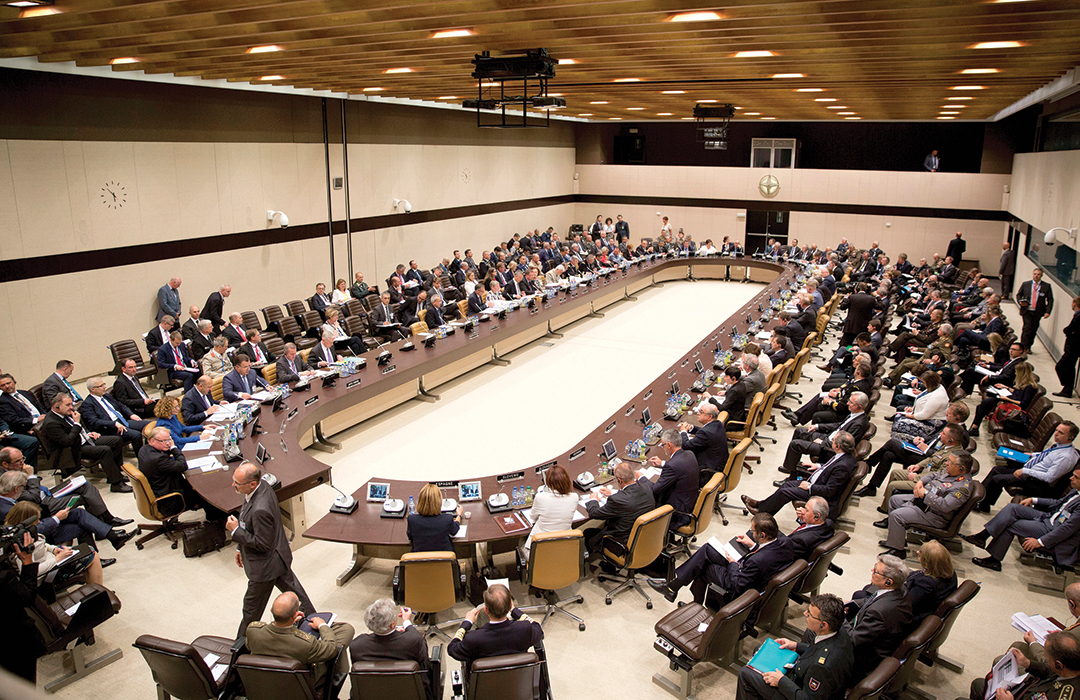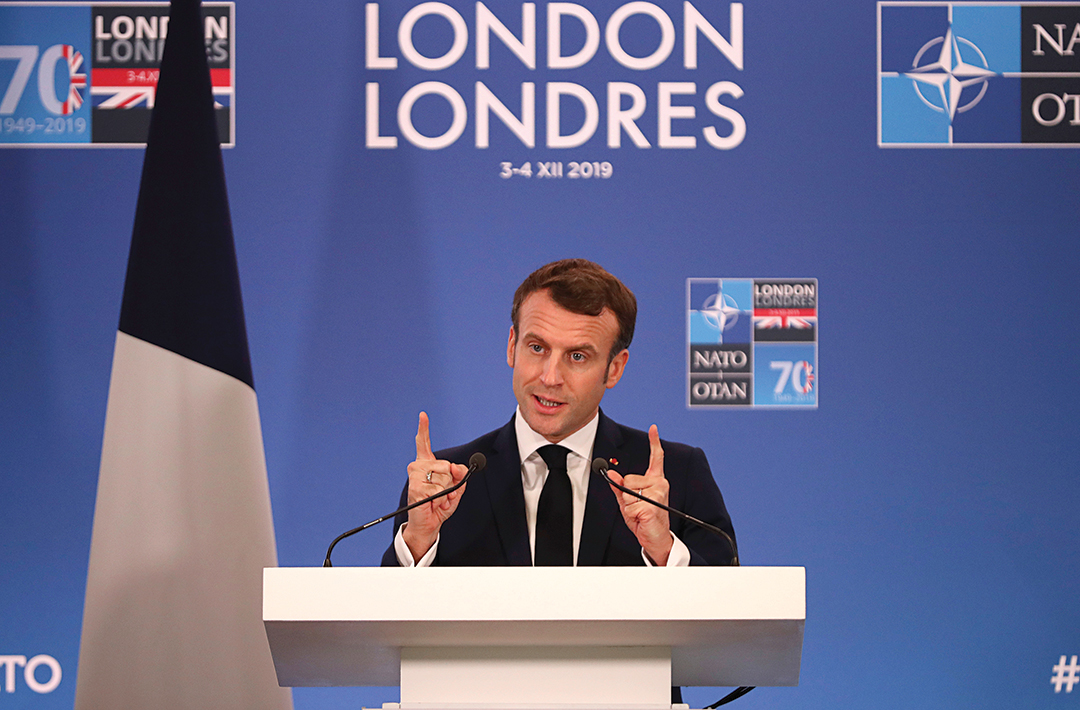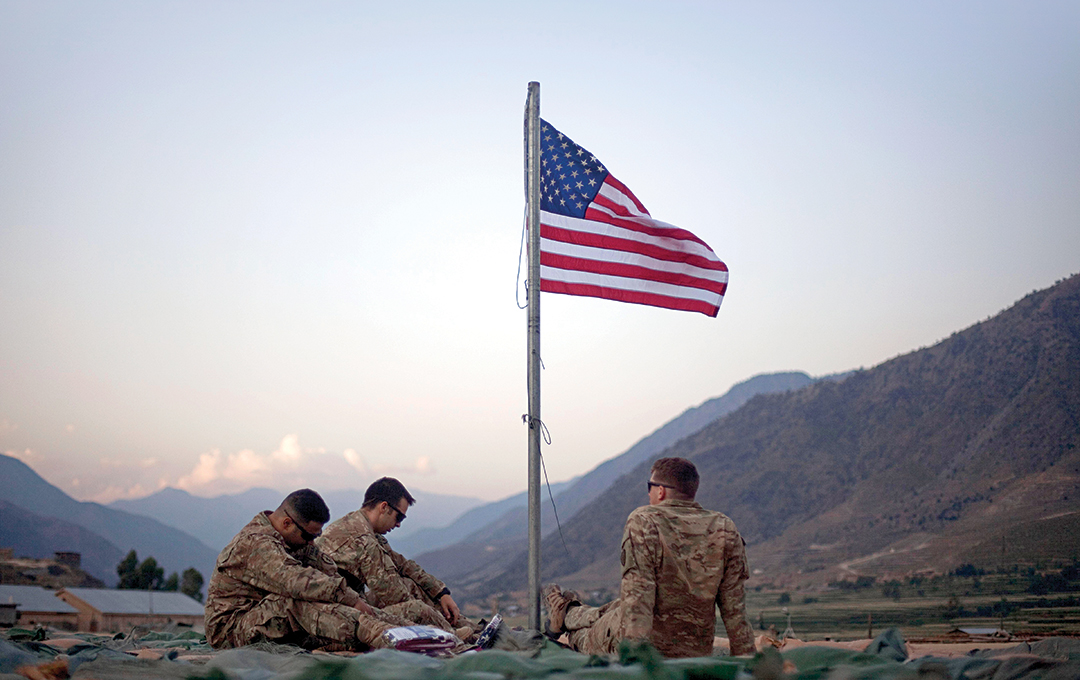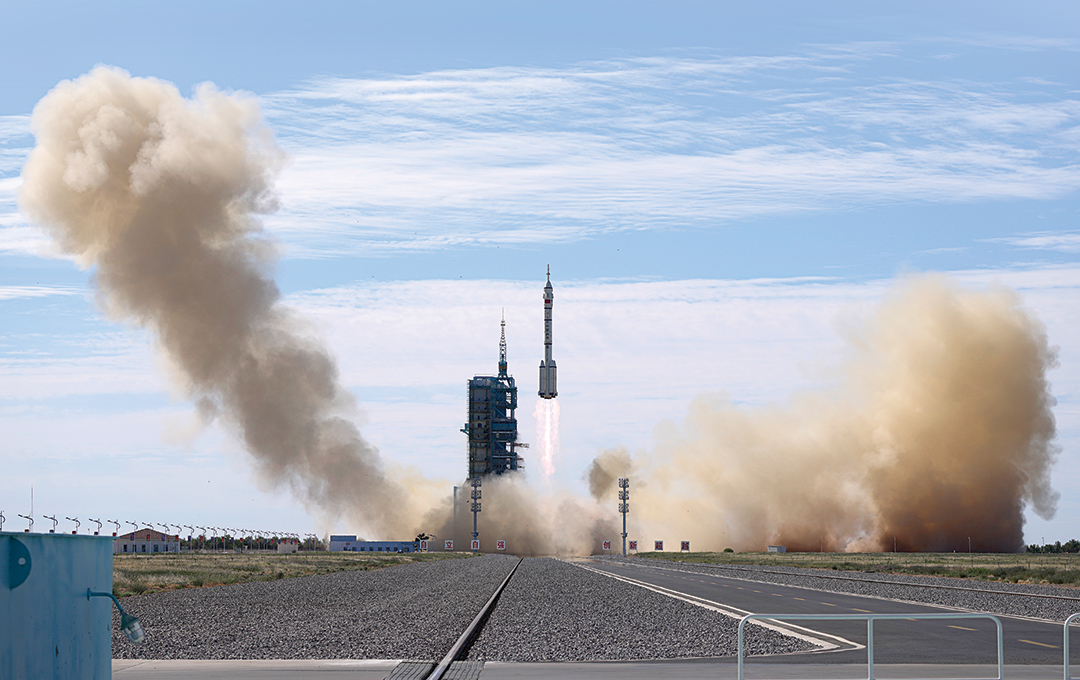Toward a New Strategic Concept
By Jan Havránek, deputy minister for defence policy and strategy, the Czech Republic
Photos by The Associated Press
The adoption of a new Strategic Concept is a logical step for NATO. The Alliance, as well as the global security environment, has fundamentally changed over the past 10 years. The world has become less predictable and more complex to navigate, and the Euro-Atlantic partners must now adapt. That is why, at the June 2021 NATO Summit, the allies agreed to develop a new Strategic Concept, sending a strong message of trans-Atlantic unity and a signal to friends and potential adversaries that NATO is strong and relevant.
This article highlights the main reasons NATO needs a new strategic document, one that better reflects today’s realities and will help the Alliance effectively face those realities. It is not a complete list of the Czech Ministry of Defence’s priorities; rather, it highlights the key tenets and gives insight into the ministry’s positions on highly debated issues.

Reasons for a new concept
Debates about the need for a new Strategic Concept have been underway since at least NATO’s 2016 Warsaw Summit. At that time, the Alliance was already facing immense pressure to deal with challenges that have since become even more pronounced. In retrospect, however, these debates were premature. NATO had only just started its military adaptation, its institutional adaptation was stagnating and its political adaptation was virtually nonexistent. Furthermore, the Alliance was waiting with anticipation for the 2016 presidential election in the United States and the policies a new administration might introduce. Donald Trump’s victory and his stance on NATO shook the very basis of the trans-Atlantic setup. Therefore, as NATO approached the Brussels Summit in 2018, there was an unspoken agreement among allies (and experts alike) that discussions about a new Strategic Concept during the Trump years could be detrimental to NATO. This thinking prevailed until U.S. President Joe Biden was elected in 2020 and he proclaimed a return to multilateralism, which rekindled the strategic debate.
Other factors also prompted NATO to take the next step in creating a new Strategic Concept:
- First, the power balance is shifting among major world players amid fast-paced technological advances. Russia, China, and other state and nonstate actors have stepped up their malign activities against the West and its allies. The sharp increase in hybrid interference (cyberattacks, disinformation campaigns, proxy forces) has become a major threat to the Alliance’s cohesion and a real test of NATO’s resilience. Issues such as emerging and disruptive technologies, the security implications of climate change, the Iran nuclear deal conundrum and space as a new domain have made this NATO agenda perhaps its most complex ever. In this security environment, the challenge is to ensure a well-balanced threat perception, free from bilateral disputes among allies.
- Second, the relationship between the two sides of the Atlantic has experienced several dynamic years. The U.S. pivot to the Indo-Pacific, coupled with Trump’s criticism of defense spending levels by NATO members, left some Europeans frustrated and questioning the U.S.’s commitment. The criticism during Trump’s presidency overshadowed a key fact: Between 2016 and 2020, defense spending by NATO countries increased along with the U.S. military presence in Europe. Internal disputes also shook the Alliance. For example, French President Emmanuel Macron’s comment about NATO experiencing “brain death” caused a lot of headaches in the run-up to the 2019 NATO Summit in London. Yet, it became a catalyst for the strategic revision, which was initially called a reflection process but later rebranded to the forward-looking NATO 2030 agenda.
- Third, the discussion about NATO’s future was escalated by the U.S. decision to end its (and consequently, NATO’s) presence in Afghanistan. The turn of events during the pullout from the country also brought to the forefront issues of trust and the balance of power within the Alliance. After such a turbulent ending to NATO’s longest mission — and the only engagement triggered by Article 5 of the Washington Treaty — the Alliance must now find answers to some very difficult questions, such as how to address the persistent capability gap between the U.S. and the rest of NATO and how to reposition the Alliance to counter terrorism.
- The final significant components that contributed to the quest for the Alliance’s new formula were the policies inspired by NATO Secretary-General Jens Stoltenberg — or the Stoltenberg Doctrine, if you will. Fundamental changes have been made during his tenure to all three pillars of the Alliance — defense, crisis management and partnerships. NATO has embraced a new direction and integrated its various ambitions and approaches into one overarching policy. With the new Strategic Concept, Stoltenberg is simply bringing the proverbial cows home.

Priorities in deterrence and defense
The Czech Republic considers it crucial that the Strategic Concept address deterrence and defense issues. Recent transformations in the security environment have changed the requirements for maintaining a strong deterrence and defense posture. Even though many of these factors have already been reflected in the Alliance’s activities and policies, the new Strategic Concept must provide a comprehensive strategy that is up to date and effective. Together, the allies must find a way to successfully counter the ever-more-frequent malign activities coming from Russia, China and other adversaries. That also requires finding a common language on China. A solid start can be found in the 2021 Brussels Communique and in NATO’s internal policies. But even with that foundation, the China issue presents real challenges. Unlike the U.S., not all allies see China as a significant rival. And some voices within the Alliance consider collective defense to be NATO’s main purpose, specifically defense of the European territory of the Alliance. This thinking, however, is not sustainable. When NATO’s strongest ally perceives China as an existential threat, and when Chinese malign activities in the areas of finance, cyber and commerce target Europe, the Alliance must react.
In addition to China and Russia, NATO must focus on a number of other challenges that are becoming ever more pronounced. Topics such as climate change and its security implications, crisis prevention and management, resource allocation, cyber and space domains, and disinformation will be central. The Alliance must make sure it adapts and takes strong positions regarding these matters.
After the experience in Afghanistan, the Alliance must also reflect on its out-of-area deployments, consider the future of military intervention and review the effectiveness of its longtime endeavor of promoting stability in the Euro-Atlantic neighborhood. The lessons from the mission show the complex nature of the U.S.’s and NATO’s roles abroad, and the difficulty of state-building. Any future endeavors must put less emphasis on military aspects and more on the wider, political and societal realities. Moreover, the Afghanistan experience raised many questions for other ongoing stabilization and state-building efforts. Europe’s and the U.S.’s missions in the Sahel, Iraq and other places in Africa and the Middle East should undergo a review to amend their future form. The allies must do their best to enhance NATO’s credibility around the world and at home. Only by doing that can the ghosts of Afghanistan be prevented from haunting them in the future. The Alliance must also find the answers to a number of other issues, such as: What will NATO’s counterterrorism military footprint look like? Will NATO be ready to use kinetic power against terrorist groups? Or will its role be reduced to assistance, training and capacity-building? If so, will this diminish the differences between NATO, the European Union and the United Nations?
NATO’s new Strategic Concept must include a strategy that will allow the Alliance to respond to “traditional” threats and to develop a new set of tools that will be used in countering hybrid interference. Finding the right balance between continuing a traditional deterrence and defense posture and adapting to new challenges will be critical. At the same time, Europe must become more independent in taking action in its immediate neighborhood. That means it will have to strengthen its posture against threats from the East and in the Sahel region. The EU’s defense ambitions should include a way to increase Europe’s capability to act, mainly by enhancing Europe’s crisis management toolbox.

NATO-EU cooperation
Like 20 other European countries, the Czech Republic is a member of both NATO and the EU. It is therefore logical that one of the Czech Republic’s main priorities is to ensure the goals set out in the Alliance’s new strategic document are adopted in cooperation with the EU to guarantee that the defense burden is shared more equally between North America and Europe. Over the past decade, Europe has learned that to remain relevant it needs to take responsibility for its share of the burden. The U.S. focus has shifted from European affairs to the Indo-Pacific and the rivalry with China. The traditional trans-Atlantic bargain, where the U.S. provides for Europe’s security in exchange for Europe’s assistance in crisis management, requires a change. The EU has set out to become more independent in its security and defense. But as discussions continue on the future shape of European defense, a new trans-Atlantic dilemma for both sides of the Atlantic emerges: The U.S. seeking more European independence risks too much of Europe drifting away from, or weakening, NATO. And for many Europeans, a diminishing of the U.S. footprint in European security and defense is not acceptable. Thus, the new trans-Atlantic bargain will require a constant calibration of the two approaches, with NATO-EU cooperation being the central pillar.
The goal is to create a partnership between the two sides of the Atlantic that is more equal and more effective. The way to strengthen the European pillar within NATO is by allowing the EU to become a platform through which Europe can level the scale. Simply put, a European action in defense that is complementary to NATO can be the solution to the issue at hand. NATO’s new Strategic Concept must take this into account and make close NATO-EU cooperation the prerequisite for any future activity, strategy or policy.
The allies’ main task now is to figure out the practical attributes of the partnership. Going forward, America’s role in Europe is expected to be primarily centered on NATO’s core tasks, i.e., collective defense and crisis management related to traditional threats (e.g., Russia or terrorism), and new domains and trends (cyber, hybrid, space, technology). It will focus on assisting Europe in enhancing its capabilities. The question is whether the EU can be autonomous in this area. The goal should not be to build the best European tank or aircraft. Europe should instead forge ahead in the new technologies sphere. It has the necessary technological know-how and, on the EU level, the financial and legal instruments needed to make a quick impact. It has the potential to keep up with the U.S.’s own strategic autonomy in this regard. Europe, in turn, will be expected to align its interests with the U.S., especially on the question of China. These realities must be considered in Europe’s next steps regarding capacity building, capability development and resource allocation.
In practical terms, this process must be based on a close, well-structured coordination between NATO and the EU that prevents duplications of effort and resources. Only such an approach can help form a system where Europe can work both independently of the U.S., if needed, and as its equal partner. If done right, NATO-EU cooperation can become the underlying force that helps the trans-Atlantic region review its shortfalls, revise its policies and prepare the West for any future challenges. Specific issues for which a strong NATO-EU cooperation can be beneficial include military mobility, information sharing, situational awareness, and new domains and threats.
New domains and threats
The need to improve capacity-building is clear, particularly with the emergence of new domains (such as space), new threats and new technologies. NATO must continue its collective capability development and innovation to boost its position as a global leader. This is especially important for the European members of the Alliance that have lagged in this field. NATO should aspire to acquire a leadership position in the technology sphere and to be a sovereign and capable player that sets the principles for responsible use. The Alliance should establish funding mechanisms and other incentives to foster research and development and technological innovation. Furthermore, NATO and the EU should establish a system for assessing the security implications of emerging and disruptive technologies. Such a system would better prepare Europe for any looming dangers or threats. An example of a successful step forward is NATO’s plan to launch its Defence Innovation Accelerator for the North Atlantic by 2023. It will add to the digital literacy of NATO members, boost cooperation on critical technologies and allow NATO to work more closely with the private sector and academia. It should also complement existing efforts by the European Defence Agency, which has been fostering public-private cooperation on innovation for the past couple of years.

In the space domain and the information space, NATO must establish itself as a strong and independent force that is capable of challenging its rivals, mainly China, various private companies and other nonstate actors. Key steps will be building a space situational awareness framework and a data-sharing network, and introducing rules and principles for working in outer space. And finally, the EU can complement NATO by providing tools that are not purely military, such as economic, political or legal instruments. Together, the two organizations can use their already existing structures, including NATO’s defense planning process and the EU’s Coordinated Annual Review on Defence, to create a functioning mechanism that will encourage reciprocity and prevent a duplication of work.
Consultations and resilience
NATO should add consultations and resilience as key functions enabling its core tasks of collective defense, crisis management and cooperative security. Consultations as a new core task would ensure better-coordinated communication among individual countries and between the North American and European blocks. For NATO to find a consensus regarding its priorities and to be able to carry out its policies successfully, increasing the importance of consultations is vital. It is particularly important in the context of NATO’s role as a world power. Alliance members must act as one when facing adversaries and when creating new partnerships and nurturing those that already exist. NATO has no other choice than to work toward greater unity because failure might mean the end of its existence. Increased consultations should become a tool to address internal disagreements or disputes. Considering the variety of outlooks and preferred defense policy approaches among individual member states, an efficient conflict-resolution framework is just what the doctor prescribed. NATO has long evaded controversial topics that could, from the outside, make it seem weak or even on the verge of breaking up. However, avoiding uncomfortable conversations is sure to do more damage in the long run.
Establishing resilience as another NATO mission is no less crucial. Building a resilient society and institutions is more essential than ever, especially in the context of NATO’s adversaries’ constant attempts to weaken and fracture the Alliance. Boosting our resilience is also vital for a credible deterrence and defense. We are experiencing an increase in hybrid interference, a decrease of public trust in Western governments and institutions, and targeted disinformation campaigns. Our resilience must improve in these fields and toward the global pandemic as well. We must adopt a strategy of prevention and of coordinated responses to both military and nonmilitary situations.

Defense spending
If NATO is to succeed in its current adaptation and meet the goals it will set out in the new Strategic Concept, it must ensure sufficient resources, both human and financial. At NATO’s Wales Summit in 2014, the allies adopted the Defence Investment Pledge, committing to reaching the 2% of gross domestic product threshold in defense spending by 2024. Meeting this deadline may be difficult for many countries, the Czech Republic included, and will not be possible without sufficient political will and a coordinated approach by all allies. Appropriate funding will be needed for a continued modernization of allied armed forces, in developing new capabilities, and maintaining NATO’s deterrence and defense posture. Without it, NATO’s plans for the future may only exist on paper.
Conclusion
The expected outcome of the NATO 2030 process is the adoption of the new Strategic Concept. The allies must reach an agreement, show cohesion and send a strong message to the world; anything less could mean the end of NATO. In the end, the ultimate precondition for a successful Strategic Concept is a strong political will underpinned by resources — financial, material and human. The responsibility lies with the leaders and the governments of all member states. Their inaction could otherwise paralyze the trans-Atlantic bond, make Europe irrelevant and weaken the entire Euro-Atlantic region.
Editor’s note: This article was completed prior to Russia’s illegal escalation of aggression against Ukraine in February 2022 and the NATO summit in June 2022.


Comments are closed.